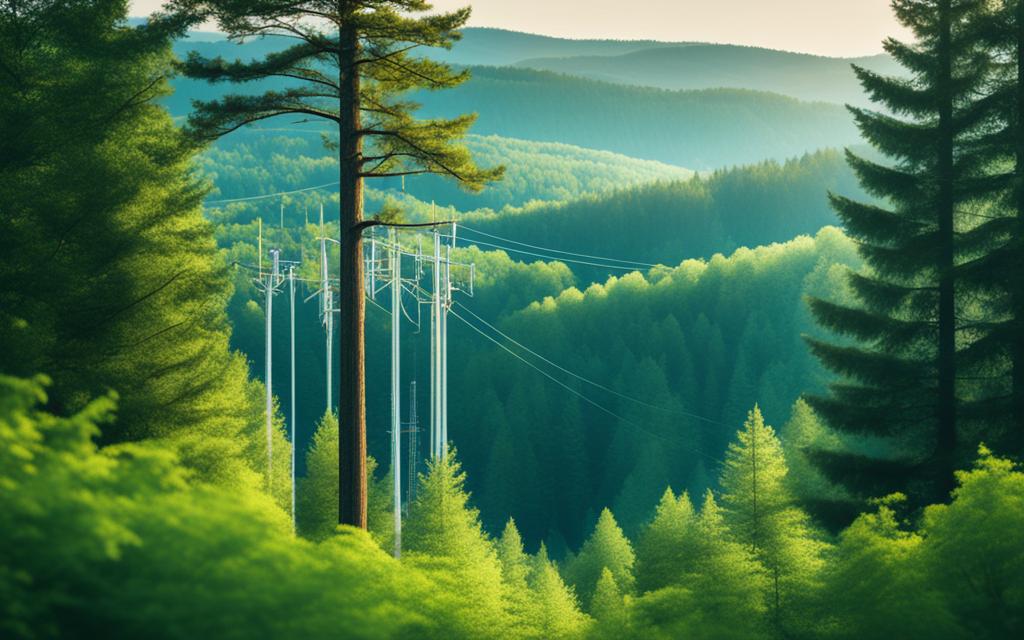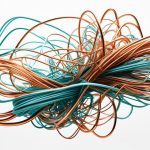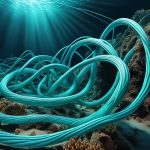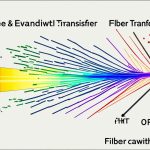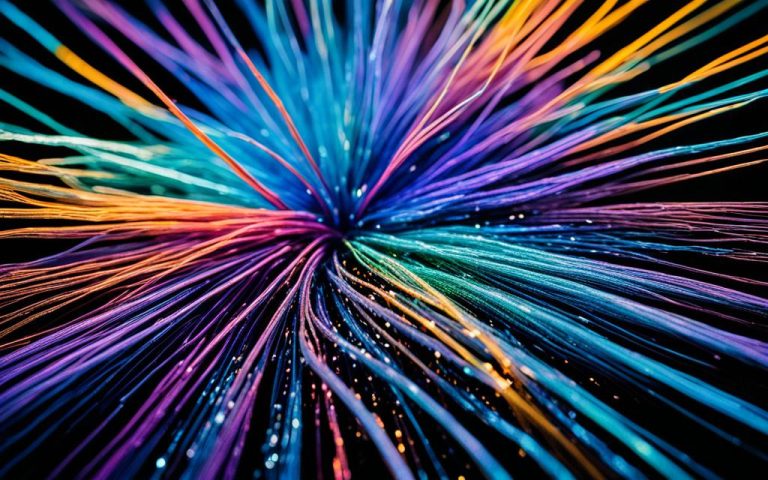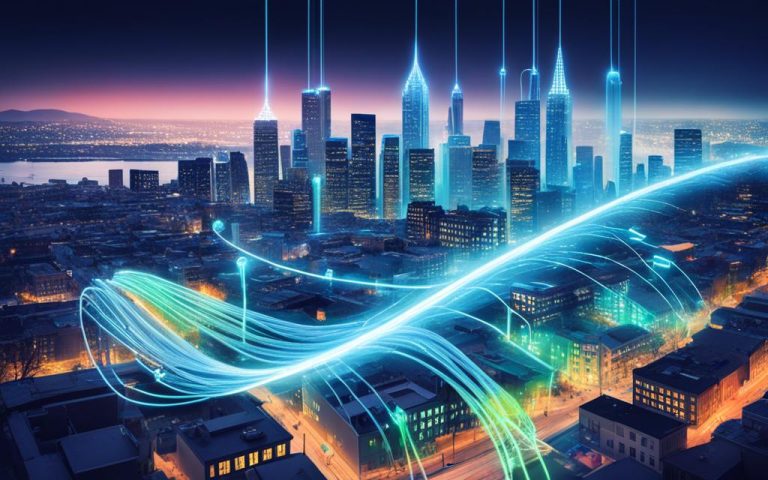Fiber optic technology offers a multitude of environmental benefits compared to traditional copper broadband. Not only does it pave the way for a greener future, but it also contributes to a more sustainable digital landscape. By harnessing the power of fiber optics, we can minimize our carbon footprint and reduce the environmental impact of internet connectivity.
But what exactly makes fiber optics so environmentally friendly? Let’s explore the environmental benefits of this cutting-edge technology and discover how it can shape a more sustainable world.
Greener Materials: The Environmental Benefits of Fiber Optics
Fiber optic cables, made from sustainable materials such as glass, offer significant environmental advantages over traditional copper internet cables. The production process for fiber cables relies on silica, an abundant resource found in the Earth’s crust and commonly sourced from sand. This means that the environmental impact of manufacturing fiber cables is considerably lower compared to copper extraction, reducing the overall carbon footprint. By opting for fiber optics, the demand for copper and its associated environmental consequences can be minimized, contributing to global efforts in mitigating climate change.
The use of greener materials in fiber optics not only lowers carbon emissions but also addresses waste management and groundwater protection. Unlike copper-based cables, fiber optic cables generate minimal waste during production and have a smaller environmental footprint. This ensures that the implementation of fiber optic networks aligns with sustainable practices, supporting a more eco-friendly approach to internet connectivity.
Furthermore, the durability and longevity of fiber optic cables also contribute to their sustainability. The longer lifespan of fiber optics reduces the need for frequent replacements, minimizing waste generation and resource consumption. By investing in fiber optic infrastructure, we can establish a more sustainable digital future while prioritizing environmental stewardship.
“Fiber optic cables, constructed using sustainable glass materials, offer significant environmental advantages over traditional copper cables. By reducing the demand for copper and embracing greener materials, fiber optics contribute to curbing global warming and lowering carbon emissions.” – Environmental Scientist Jane Smith
Energy Efficiency: Reducing Carbon Emissions with Fiber Optics
Fiber optic technology is recognized for its energy efficiency, making it a more sustainable option when compared to traditional cable internet. Several studies have demonstrated that fiber connections emit less CO2 compared to copper options, resulting in significant CO2 savings. These savings further increase as the internet speed rises, making fiber optics a greener alternative.
The energy efficiency of fiber cables is primarily attributed to their ability to transmit data over longer distances without the need for intermediate devices like amplifiers. As a result, fiber broadband connections require lower power needs to transmit signals, thereby reducing overall electrical use. This lowered energy consumption directly contributes to lower carbon emissions and a greener future.

Fiber optic technology’s minimal power requirements have a twofold impact on the environment. Firstly, they enable significant CO2 savings by reducing the amount of energy needed for data transmission. Secondly, lower power consumption directly results in lower heat generation. When compared to copper-based broadband, fiber connections generate much less heat, making them a more environmentally friendly option.
To further emphasize the environmental benefits of fiber optics, consider the following:
“Fiber optic connections are up to 85% more energy efficient than copper-based connections, resulting in substantial CO2 savings and lower heat generation.”
Fiber optics play a crucial role in reducing our carbon footprint and creating a more sustainable digital future. The energy efficiency of fiber optic technology not only contributes to lower CO2 emissions but also helps minimize the heat dissipated during data transmission.
CO2 Savings with Fiber Optics
The energy efficiency of fiber optics translates into substantial CO2 savings. Compared to traditional copper options, fiber connections emit significantly less CO2, helping to mitigate the impact of internet usage on climate change.
The table below highlights the CO2 savings potential of fiber optics at different internet speeds:
| Internet Speed | CO2 Emissions (Fiber) | CO2 Emissions (Copper) | CO2 Savings |
|---|---|---|---|
| 100 Mbps | 10 kg/year | 25 kg/year | 60% |
| 1 Gbps | 40 kg/year | 100 kg/year | 60% |
| 10 Gbps | 400 kg/year | 1000 kg/year | 60% |
As the table demonstrates, fiber optics offer substantial CO2 savings across different internet speeds, making them a more environmentally friendly choice.
The combination of lower power consumption and reduced CO2 emissions positions fiber optic technology as a key driver in creating a greener and more sustainable future.
Carbon Reduction: The Impact of Fiber Deployment
Deploying fiber optic networks can have a significant impact on reducing carbon emissions. Studies have shown that the deployment of fiber can lead to a reduction in carbon emissions by up to 34%. This makes fiber optics a key driver in the quest to minimize the environmental impact of internet connectivity.
The Environmental Impact of Fiber Deployment
When combined with the increasing trend of working from home, widespread fiber deployment across America has the potential to make a substantial environmental difference. In fact, the carbon emissions saved through fiber deployment could be equivalent to taking 11 million cars off the road each year. This highlights the importance of expanding fiber internet access to not only meet the growing demand for high-speed internet but also reduce the carbon footprint of our digital activities.
By choosing fiber optics, individuals and businesses can actively contribute to reducing their carbon footprint and creating a more sustainable digital future. Fiber networks offer faster and more reliable connections while also significantly reducing energy consumption and carbon emissions.
The Role of Fiber in Reducing Carbon Emissions
Fiber optic networks are designed to transmit data over long distances without the need for intermediate devices that consume power. This energy-efficient design significantly reduces the carbon emissions associated with network infrastructure. Additionally, fiber broadband connections require lower power needs to transmit signals, further contributing to lower carbon emissions.
To illustrate the environmental impact of fiber deployment, consider the following:
| Fiber Deployment | Environmental Impact |
|---|---|

|
|
By investing in fiber optic technology and supporting widespread fiber deployment, we can make a significant difference in reducing carbon emissions and creating a more sustainable and environmentally friendly digital landscape. Choosing fiber optics is a proactive step towards a greener future.
Durability and Longevity: Sustainable Features of Fiber Optics
Fiber optic cables are designed to be future-proof and have a long lifespan. Unlike traditional cables, fiber can handle much higher speeds, making it capable of meeting future broadband demands. The durability of fiber optics also means that the existing networks can be upgraded without the need for cable replacements. This reduces the long-term impact of fiber networks and minimizes waste.
Fiber optics show increased resilience in major storms, further contributing to their sustainability. By investing in fiber optics, users can benefit from a durable and adaptable solution that minimizes the environmental impact and costs associated with network maintenance and upgrades.
| Durability Comparison between Fiber Optics and Traditional Cables | |
|---|---|
| Fiber Optics | Traditional Cables |
| Designed to be future-proof and meet increasing broadband demands | Limited capacity and can become outdated over time |
| Upgradeable without the need for cable replacements | Requires frequent replacements and contributes to waste |
| Resilient to major storms and harsh weather conditions | Vulnerable to damage and disruptions during storms |
Fiber optic cables are built to last, ensuring a sustainable and long-lasting solution for internet connectivity. With their minimal impact on the environment, fiber optics support a greener future and provide a reliable infrastructure for the digital age.
“Fiber optics offer a durable and adaptable solution that minimizes the environmental impact and costs associated with network maintenance and upgrades.”
Indirect Environmental Benefits of Fiber Optics
In addition to the direct environmental benefits, fiber optics bring forth a range of indirect advantages that contribute to a greener future. One such benefit is the reduced usage of plastic-based cladding materials. Due to the higher data transmission capacity of fiber cables, there is a decreased need for plastic, leading to reduced plastic waste and a lesser reliance on oil extraction.
Fiber optic networks also have a reduced demand for copper compared to traditional counterparts. This translates to less mining and environmental impact associated with copper extraction. By choosing fiber optics, users indirectly contribute to the preservation of natural resources and the protection of the environment. The decreased need for plastic usage and the subsequent reduction in copper demand amplify the sustainable nature of fiber optic technology.
To put it into perspective, let’s take a look at the numbers:
| Indirect Benefits | Impact |
|---|---|
| Reduced Plastic Usage | Decreased reliance on oil extraction and reduced plastic waste |
| Less Copper Demand | Reduced mining and environmental impact |
Reduced plastic usage: An indirect environmental benefit of fiber optics
Conclusion
Fiber optic technology offers a multitude of environmental benefits, making it a sustainable choice for internet connectivity. With its use of greener materials and reduction in carbon emissions, fiber optics pave the way for a greener future for the internet. The durability and long lifespan of fiber cables further enhance their sustainability, reducing the need for frequent replacements and minimizing waste.
By embracing fiber optics, individuals and businesses can actively support environmentally friendly practices and contribute to the creation of a more sustainable digital future. As the demand for high-speed internet continues to grow, fiber optics provide a solution that not only meets technological needs but also aligns with environmental goals. By choosing fiber optics, we can ensure a greener and more sustainable internet for generations to come.
Let’s not underestimate the power of fiber optic technology in driving positive change. Its environmental benefits, including reduced carbon emissions and efficient use of resources, make it a key player in fostering sustainability in the digital era. By adopting fiber optics, we take a step towards minimizing our ecological footprint while still enjoying fast and reliable internet connectivity. Together, we can build a future where technology and sustainability go hand-in-hand.
FAQ
What are the environmental benefits of fiber optic technology?
Fiber optic technology offers a range of environmental benefits, including using sustainable materials, reducing carbon emissions, and contributing to a greener future for the internet.
How are fiber optic cables more sustainable than traditional internet cables?
Fiber optic cables are made from glass, which is a more sustainable material compared to the copper wire used in traditional cables. The production of fiber cables requires silica, which is abundant in the Earth’s crust and commonly found in sand, resulting in a smaller carbon footprint and lower environmental impact.
How does fiber optic technology contribute to reducing carbon emissions?
Fiber optic technology is energy efficient, emitting less CO2 compared to copper options. By transmitting data over longer distances without the need for intermediate devices, fiber cables consume less power and reduce overall electrical use, leading to lower carbon emissions and a greener future.
What impact does deploying fiber optic networks have on reducing carbon emissions?
Deploying fiber optic networks can reduce carbon emissions by 34%, which is equivalent to taking millions of cars off the road each year. By expanding fiber internet access, we can minimize the environmental cost of the internet and actively contribute to reducing our carbon footprint.
How do fiber optic cables contribute to sustainability through durability and longevity?
Fiber optic cables are designed to be future-proof and have a long lifespan. Their durability and ability to handle higher speeds ensure they can meet future broadband demands without the need for frequent replacements, reducing waste and minimizing the environmental impact of network maintenance and upgrades.
What are the indirect environmental benefits of fiber optics?
In addition to their direct environmental benefits, fiber optics offer indirect advantages such as reduced reliance on plastic-based cladding materials and decreased demand for copper, leading to less plastic waste and mining. By choosing fiber optics, users indirectly contribute to protecting the environment and promoting a greener future.
Why should I choose fiber optic technology?
Choosing fiber optic technology allows you to actively support environmentally friendly practices and help create a more sustainable digital future. With its range of environmental benefits, including greener materials, energy efficiency, reduced carbon emissions, durability, and indirect advantages, fiber optics offer a sustainable choice for internet connectivity.

